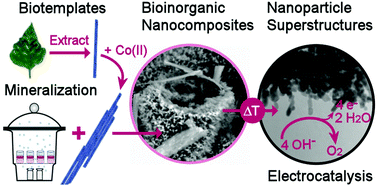Virus-directed formation of electrocatalytically active nanoparticle-based Co3O4 tubes†
Abstract
Spinel-type Co3O4 finds applications in a wide range of fields, including clean energy conversion, where nanostructured Co3O4 may provide a cost-efficient alternative to platinum- and iridium-based catalysts for electrocatalytic water-splitting. We here describe a novel strategy in which basic cobalt carbonate – a precursor to Co3O4 – is precipitated as sheet-like structures and microspheres covered with fine surface protrusions, via ammonium carbonate decomposition at room temperature. Importantly, these mild reaction conditions enable us to employ bio-inspired templating approaches to further control the mineral structure. Rod-like tobacco mosaic viruses (TMV) were used as biotemplates for mineral deposition, where we profit from the ability of Co(II) ions to mediate the ordered assembly of the virus nanorods to create complex tubular superstructures of TMV/ basic cobalt carbonate. Calcination of these tubules is then achieved with retention of the gross morphology, and generates a hierarchically-structured solid comprising interconnected Co3O4 nanoparticles. Evaluation of these Co3O4 materials as electrocatalysts for the oxygen evolution reaction (OER) demonstrates that the activity of Co3O4 prepared by calcination of ammonia diffusion-grown precursors in both, the absence or presence of TMV exceeds that of a commercial nanopowder.



 Please wait while we load your content...
Please wait while we load your content...